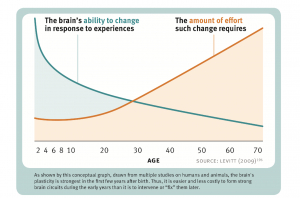Neuroplasticity
Neuroplasticity is the ability of the brain to rapidly change its default activity in response to stimuli by reorganizing how it works by modifying connectivity. Humans lose their neuroplasticity after 35 years of age[1][2] (see figure 1), recent studies have shown this can be temporarily reversed by types of shock.

The brain is neurochemical in nature, meaning it is part electric and part chemical. When these systems combine they work like hiking trails; the pathways that get a lot of traffic get smoother and wider, with brush stomped down and pushed back. The neural pathways that sit unused grow over, becoming less likely to be used. Your brain uses the more accessible pathways as it takes lower energy to do so. In times of crisis people nimble on their feet are of paramount importance.
References
- ↑ 1.0 1.1 Changes in plasticity across the lifespan: Cause of disease and target for intervention. Publish 10 April 2015, accessed on 3rd March 2022, via https://www.ncbi.nlm.nih.gov/pmc/articles/PMC4392917/
- ↑ Molecular aging of the brain, neuroplasticity, and vulnerability to depression and other brain-related disorders. Dialogues in Clinical Neuroscience. Volume 15, 2013 - Issue 1. Etienne Sibille Pages 53-65 | Published online: 01 Apr 2022. Accessed 19th Jun 2022 via https://www.tandfonline.com/doi/full/10.31887/DCNS.2013.15.1/esibille